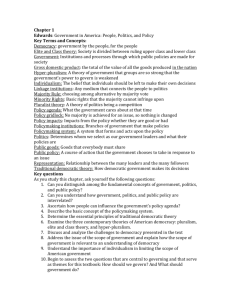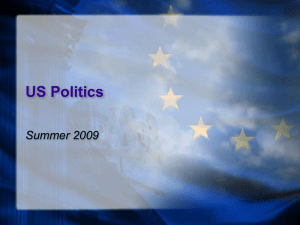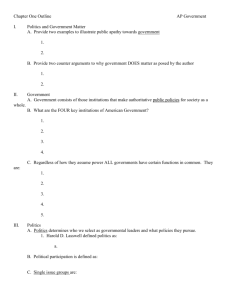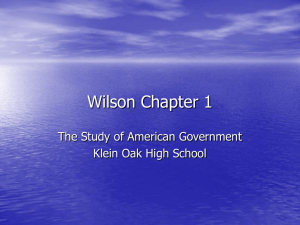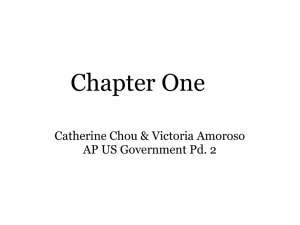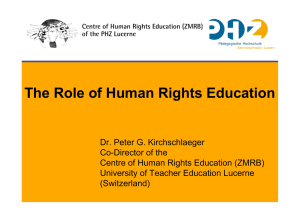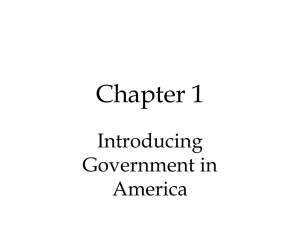Input Driving CIVIC Participation Through Social Media by Dr Andy Williamson
advertisement
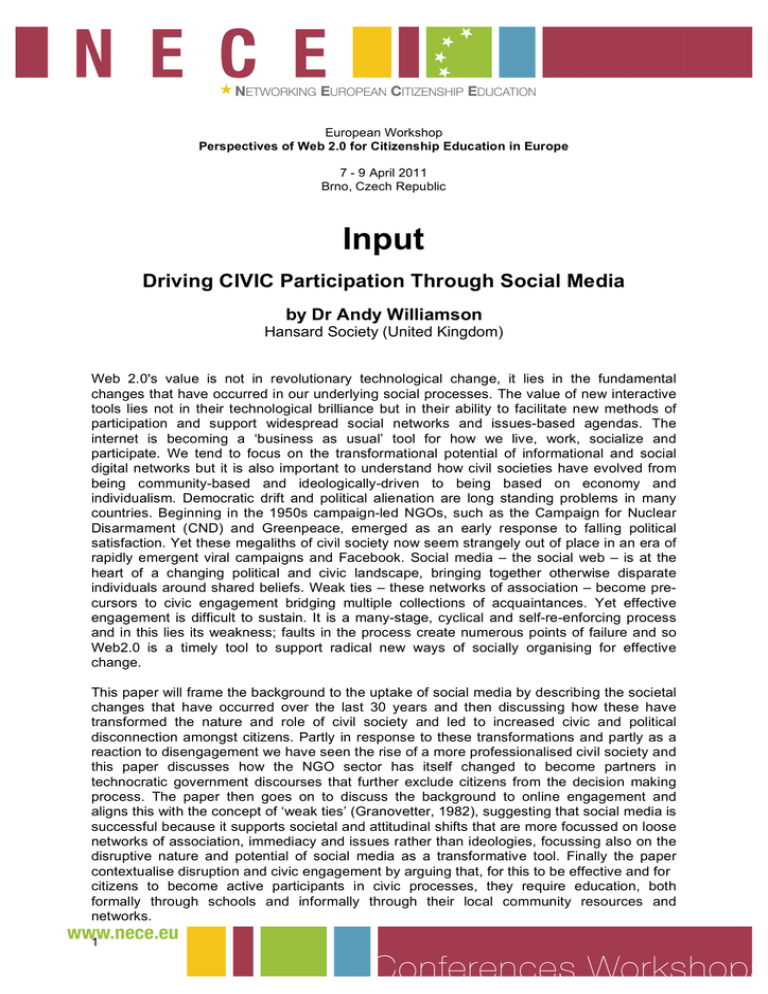
European Workshop Perspectives of Web 2.0 for Citizenship Education in Europe 7 - 9 April 2011 Brno, Czech Republic Input Driving CIVIC Participation Through Social Media by Dr Andy Williamson Hansard Society (United Kingdom) Web 2.0's value is not in revolutionary technological change, it lies in the fundamental changes that have occurred in our underlying social processes. The value of new interactive tools lies not in their technological brilliance but in their ability to facilitate new methods of participation and support widespread social networks and issues-based agendas. The internet is becoming a ‘business as usual’ tool for how we live, work, socialize and participate. We tend to focus on the transformational potential of informational and social digital networks but it is also important to understand how civil societies have evolved from being community-based and ideologically-driven to being based on economy and individualism. Democratic drift and political alienation are long standing problems in many countries. Beginning in the 1950s campaign-led NGOs, such as the Campaign for Nuclear Disarmament (CND) and Greenpeace, emerged as an early response to falling political satisfaction. Yet these megaliths of civil society now seem strangely out of place in an era of rapidly emergent viral campaigns and Facebook. Social media – the social web – is at the heart of a changing political and civic landscape, bringing together otherwise disparate individuals around shared beliefs. Weak ties – these networks of association – become precursors to civic engagement bridging multiple collections of acquaintances. Yet effective engagement is difficult to sustain. It is a many-stage, cyclical and self-re-enforcing process and in this lies its weakness; faults in the process create numerous points of failure and so Web2.0 is a timely tool to support radical new ways of socially organising for effective change. This paper will frame the background to the uptake of social media by describing the societal changes that have occurred over the last 30 years and then discussing how these have transformed the nature and role of civil society and led to increased civic and political disconnection amongst citizens. Partly in response to these transformations and partly as a reaction to disengagement we have seen the rise of a more professionalised civil society and this paper discusses how the NGO sector has itself changed to become partners in technocratic government discourses that further exclude citizens from the decision making process. The paper then goes on to discuss the background to online engagement and aligns this with the concept of ‘weak ties’ (Granovetter, 1982), suggesting that social media is successful because it supports societal and attitudinal shifts that are more focussed on loose networks of association, immediacy and issues rather than ideologies, focussing also on the disruptive nature and potential of social media as a transformative tool. Finally the paper contextualise disruption and civic engagement by arguing that, for this to be effective and for citizens to become active participants in civic processes, they require education, both formally through schools and informally through their local community resources and networks. 1 Background Since the 1980s society has radically shifted away from a culture of community towards a culture of individualism framed around the economic imperative. We are no longer simply citizens, we are consumers. The rationalisation of public services into efficient ‘business units’ has paralleled a rise in the role of a technocratic elite. Although genuine examples exist of good attempts to engage the public, governments can at times appear arrogant (Galbraith, 1992, p. 67) and to distrust the public, privileging the expertise of select groups of (often exgovernment) consultants and experts. Even where the public are consulted, the primacy of expert opinion can appear to de-value citizens’ views, leading to feelings of dislocation and a concomitant fall in civic responsibility (Mälkiä, Anttiroiko, & Savolainen, 2004; Williamson, 2007). The result is that, in the UK, only 43% of citizens want to be involved in decision making (Hansard Society, 2009). Of the citizens who do not wish to become involved, 40% say that this is because of a lack of time. I would argue it is at least as much about motivation and, whilst the internet does not of itself change an individual’s motivation to become engaged, it can reduce those barriers to engagement and hence lower the motivational threshold at which citizens choose to engage (Williamson, 2007). Lending weight to the relevance of a motivational dimension, 85% of citizens report that they feel that they exert little or no influence over national-level decisionmaking (Hansard Society, 2009). Political disaffection is not, Hay, Stoker and Williamson (Hay, 2008, p. 1) suggest, “a story of the decline of civic virtue, nor is it a story of political apathy – it is one of disenchantment, even hatred, of politics and politicians”. Politics is a compromise; position and counterposition. Elected representatives are there to make laws, to set the priorities of government (if in power) or to challenge, contest and present alternatives (if in opposition). In the past it has been easy to tell political parties from each other as deep ideological differences existed. The political landscape has changed so that, in the early part of the 21st century, ideology seems largely to have been left behind, with policy direction and manifestos determined by focus groups and public sampling; politics as a product. Campaigning is no longer restricted to the period before an election but is a constant throughout the electoral cycle in various forms (Williamson, Miller, & Fallon, 2010). The media has played a significant role in this process. Never overly independent, they have preferred short-term and negative reporting (Oborne & Walters, 2004; Russell, 2005). News reporting has moved away from an historical position of reporters of facts to self-appointed mediators between the public and (in their discourse) our not-to-be-trusted politicians (Gustafson, 2001). Civil Society and Civic Disconnection The transformation in the roles of government, media and citizens has created a void in modern society (Power Inquiry, 2006). Two challenges have arisen as a result of the foregoing, the first being the privileging of the individual over the collective, thereby reducing opportunities for citizens to be engaged, debate and modify their beliefs (Richardson, 2004). The second revolves around the difficulties involved in reasserting an independent public sphere when it remains colonised by powerful corporate interests, media outlets and technocratic agencies (Wilhelm, 2000). These challenges can to some degree be mitigated by a strong civil society, characterised by the ascendancy of the non-governmental organisation (NGO). Many regard this as a sign of a healthy democracy, yet it is also the case in modern Britain that civil society organisations have to some extent bought into the technocratic arguments of government and positioned themselves as the experts of choice when it comes to representing the views of a wider public, regardless of the extent to which that public has actually been consulted or agreed to being represented. It is somewhat simplistic to frame this as a criticism of NGO activities, indeed one can strongly argue that such NGOs are simply stepping into the democratic void created by a failing public sphere but it does present a risk for a strong democracy. 2 Civil society is synonymous with “the realm of public institutions apart from the state” (DeWiel, 2000, p. 11). Inherently non-profit-making, they act locally, nationally, even internationally, and are focused on defending and promoting the social, economic and cultural interests of their stakeholders (whoever these might be) for mutual benefit. An ideal civil society, therefore, reflects an inter-connection of individuals and groups beyond economic and state systems, with varying degrees of formality and structure. Social movements come and go, emerging to challenge hegemonic values, existing social orientations and “the modality of the social use of resources and cultural models” (Touraine, 2000). As such, civil society has become an inherent component of democratic life (Verba, Nie, & Kim, 1978). What distinguishes civil society is that its demands are ethical and cultural, not economic, constructing “a set of mediations which are at once social and political, and which exist midway between political programmes and social situations” (Touraine, 2000). A vibrant civil society theoretically enables a public sphere in which systems are held to account, where citizens are able to challenge the misuse of power and in which influence can be exercised. It is in theory at least the coordination of uncoerced action through communicative interaction (Habermas, 1987): In the associations of civil society people co-ordinate their actions by discussion and working things out, rather than by checking prices or looking up rules (Young, 2000, p. 159). Government in particular often assumes that an active civil society and participation in it should be encouraged because it: leads to better and more responsive services; tackles people’s disengagement from politics and the democratic process; and builds social capital (Skidmore, Bound, & Lownsbrough, 2006, p. 6). Professionalising the Public Sphere The shift towards the professionalization of civil society, itself a direct response to neoliberalism (Bondi & Laurie, 2005) and resultant “socio-spatial polarisation” (Larner & Craig, 2005, p. 404), is seen by some as a “double-edged sword” (Katz, 2005, p. 629). In addition to the rise of activist-organisations, neoliberalism has led to a significant increase in neo-communitarian service-based NGOs, focusing on social cohesion and framed within a civil society context that is reliant on strategic compacts with local and national government (Fyfe, 2005). The increased use of digital media theoretically positions third-sector organisations more strongly as democratic actors and ‘information intermediaries’ (Burt & Taylor, 2004). The large NGOs are corporatized, run by professional managers and able to orchestrate significant campaigns to effect influence and affect government policy in their areas of interest (Fyfe, 2005). Membership of campaign organisations serves two purposes; first, it suggests a level of support and, therefore, importance and power and, second, it brings in revenue to allow campaigns to be funded. Despite their role as democratic actors there is no inherent pre-requisite for NGOs to act democratically themselves; most supporters give money but take no active role or oversight in the organisation. Whilst participatory frameworks are intended to support the building of social capital and actively engage people in democratic processes, such social capital appears “valuable to some people at some times and places, and not at all valuable in others” (Skidmore et al., 2006, p. 11) and is not evenly distributed. Social capital is often embodied in the key relationships that exist between individuals or organisations across civil society, access to it is, therefore, negotiated via a range of background factors that include socio-economic status, geographical circumstances, ethnicity, religion, age, gender and sexual orientation (Coleman, 1988; Putnam, 2000). 3 The foregoing does not suggest that NGOs are not a vital component of the democratic landscape, only that caution is needed when such organisations claim to ‘represent’ citizens. It highlights too a creeping polarisation between ‘grassroots’ civil society and corporatized NGOs (Fyfe, 2005; Knight, 1993). The ability to participate effectively is not neutral and is intensified or mitigated by the factors discussed above, because those participating in decision-making are often a small inside elite and because the systems of democratic engagement are themselves a barrier to participation for some (Bowler, Donovan, & Karp, 2002). As such, there exists a gap within our framework of civil society where digital media can be used to support informal, emergent issues-based citizen-led groups, reclaiming “spaces of ‘reality’ or ‘resistance’” (Fyfe, 2005, p. 553). Online Engagement Some commentators fear that the internet is leading to a fragmentation of the public sphere, others that it enables a more organic form of political engagement, fostering engagement by local communities. Rather than assume that diverse groups and opinions require shepherding into a unitary public sphere, advocates of internet-enabled governance suggest that areas of civic interest congregate online and networks emerge that lead to new forms of engagement. The internet does not of itself change an individual’s motivation to become engaged, but it can reduce the barriers to engagement and hence lower the motivational threshold at which citizens choose to engage (Williamson, 2007). Such re-invigoration of civil society can itself be a catalyst for democratic renewal and, as Sunstein (2001) argues, the internet in this regard is at least not bad for democracy. As far back as 2002 the British Government suggested that new media could support a restructuring of the relationship between citizens and state: [An] e-Democracy policy should be viewed in a context of those political and constitutional reforms, which seek to devolve power, extend citizens’ rights and improve the transparency and accountability of government and politics (Cabinet Office, 2002). The findings of the Hansard Society’s Digital Dialogues project – a three-year study of online government engagement (Miller & Williamson, 2008) – highlight the benefits of what happens when citizens and government do talk online and why there is a need for a more sustained public deliberation with government. Standing in the way of this ‘effective engagement’ are barriers on both sides. On the government side, these include a lack of ‘buy in’ to the principles of true engagement and a culture that is inherently averse to risk – and which perceives engaging with a non-expert public as high risk. The internet too facilitates the kinds of single-issue politics that are becoming increasingly popular offline and which do not necessarily link back to traditional democratic processes or institutions. Instead, citizen-led online activism tends to be viral and anarchic, leading to a distributed model of political individualism (Williamson, 2010). Nor do new technologies necessarily lead to an increase in the numbers of people participating. The internet provide access to far more information but the overload arising from this could account for a reduction in participation (Bimber, 1998). Information is often conflicting and contradictory, yet it appears to be online human-nature to congregate around like-minds, rather than to actively seek out difference (Witschge, 2002). 4 The Weak Ties of Social Media How engagement occurs for individuals will depend on motivation but also on their sense of both an individual and collective benefit. Stronger identification with a particular community would hopefully result in a greater level of political participation (Rousseau, 1968). Putnam (1995) argues that a decrease in social relations has resulted in a decrease in social capital and this has led to a decline in political participation in general because the strong social networks between citizens that encourage engagement are eroded. Consider also the distinction between strong ties that exist amongst friends and family and the weak ties that exist between members of civil society more widely. Figure 1: Varying strengths of ties in different parts of day-to-day life As Figure 1 shows, as we move from the individual outwards, the strength of ties between citizens become weaker, representing multiple collections of acquaintances as opposed to the close-knit family group towards the centre of the diagram. Yet it is these weak ties that bring together otherwise disparate individuals around shared beliefs (Granovetter, 1982). The power of weak ties highlights the importance of maintaining long term contact across social networks since it is in the maintenance of weak ties that social media is particularly effective. The Emergence of Social Media Effective online engagement as discussed above presupposes a shift from the informational to the participatory. Both of these activities lie within the Web1.0 continuum and remain firmly anchored in the internet landscape. Going beyond these we have now introduced concepts collectively known as Web 2.0, referring to the ‘social’ or ‘user generated’ web. This means websites and applications that are driven by two key factors: data provided by external third parties and the ability of tools to support interconnectivity and networking. Where online information repositories, Wikipedia and government engagement websites are firmly rooted in the Web 1.0 world, tools such as Facebook, Twitter and Four Square clearly align with the definitions of Web 2.0. Where value was previously derived from information (either providing or receiving) in a Web 2.0 world it lies in connecting – the building of weak ties and networks of association. 5 Figure 2: The ecology of digital spaces The next phase of evolution lies around the bringing together of formally instantiated data and user-driven data to power new tools that rely on collaborative works, in part through the use of semantic searching and analysis techniques. An example of this was the work done by the Guardian newspaper to publish data sets for MPs expenses, that the public could then access and in turn build up a collaborative analysis. The second facet of the collaborative web is to do with how we access the internet, moving from static single locations to always on, always with us mobile devices and applications – the future is data-enabled and mobile. It is the power of user-generated content, collaboration and mobile that makes the internet a core tool for engagement. These tools are inherently focussed around the networks of association that hold people loosely together, making it easier for leaders to emerge and to motivate and connect with others in order to take action. Disruption The internet is an ideal support tool for citizen engagement because of its viral, emergent, connected and rapid nature but is only a reflector of the society around it; it is only through the social appropriation of technology that it gains value. Today we are living in the midst of a global economic crisis. Whilst its impact and effect is more obvious in some European countries than in others, it none the less looms large as a spectre across the EU. It is also the rationale presented for the reduction in public spending. Public services are again subject to major review, reform and reconstruction, which in effect means deconstruction and outsourcing the delivery without the requisite funding. The UK’s ‘Big Society’ represents a shift in ideological thinking that, its proponents claim, will reinvigorate local communities, reduce government bureaucracy and waste and put decision making powers back at the heart of citizenship. Opponents argue that it is a cynical attempt to cut expenditure (and therefore taxation), in effect cutting loose the most vulnerable with little or no safety net. It is hard to argue with the basic concepts of the ‘big society’; many communities across Europe have for many years empowered themselves and taken action. Many have achieved great results but many too fail, either because they lack resources (money, people, time), because the system they are trying to change is so impenetrable, resistant and ultimately, unwilling to respond or because they have failed to generate the scale or the reach needed to achieve their ultimate goal. Across the Middle East and North Africa we are witnessing a rising tide of citizen-led protest against autocratic and corrupt regimes. In echoes of the Czech Spring of 1968 and the tumultuous wave of change that swept across Eastern Europe during the 1990s, there is a real feeling that change is real, can happen and can be sustained. There is a new and emergent spirit of pan-Arabism, with activists in one country following and gaining confidence (and support) from those in others. There is nothing new in this; we have seen such movements before during the 1960s and the 1980s. Some of the countries that are today rising up for change were the same ones who were brutally repressed 50 years ago. The difference between then and now is the rise of digital media and a globalised 24x7 news culture. 6 Key tools for the modern revolution are digital because they achieve significant things; first, they bring together otherwise remote and disparate groups. Second, they create channels to bypass traditional state control of the media so the outside world (in other words, foreign media) can see what is going on. Alongside traditional activism and action, the tools of the trade today are the internet (for information dissemination and news), social media (to connect and coordinate), mobile phones (to capture what happens) and digital, particularly satellite, television to report it. The underlying complexity of the network is an important factor too. Whilst many regimes would like to simply turn off the internet, this is very difficult to do completely. Activists on the ground and net-savvy supporters around the world are able to implement proxy techniques to evade detection and bypass the controls of states. Flows of information can be slowed but not stopped; the world is now simply too porous. Social media is important because it is an ideal tool for connecting loose networks of association, bringing together otherwise disparate groups and individuals to support a common cause. It is no respecter of borders. What happens in Morocco and Egypt motivates and empowers protesters in Libya, Syria and Yemen. We saw digital activists from Morocco support Egyptians, teaching them how to exploit these new tools. One must be careful not to overstate the role of social media; it is only a tool. The previous example was largely done face-to-face, not online, and what social media can achieve is down to alignment with social behaviour and its effective social appropriation. That said, social media does play an important part in contemporary revolutionary movements; we are seeing around 40-45 tweets per minute from Egypt and 30-35 per minute from Syria and Libya. Twitter receives much media attention, perhaps because it is more visible to the media. Therein lies its value, as a tool to tell your story to the world. This is reflected in the significant number of tweets in English, particularly from Egypt at the time of the Tahrir Square occupation. Equally Facebook’s role in Egypt and across North Africa is to show a growing mass public that they are not alone; suddenly made visible on their social networks is an emerging pan-Arab movement for change, from which individual citizens have quickly taken courage and then action. Facebook has proven a key tool for collaboration and network-formation, Twitter for coordinating action quickly in real time and both Twitter and YouTube provide a documented public record for the outside world. Perhaps most telling is that the use of social networking sites such as Facebook to organise and promote demonstrations is now mentioned in passing, almost casually by those involved. What we are seeing in North Africa today mirrors what we saw in Germany and the UK during recent elections. First, a media wanting to portray Web 2.0 as being more important than it really is but, more importantly, clear evidence that the internet – blogs, Facebook, Twitter; citizen journalism and the consumption of these – is becoming normative: it is business as usual, at least it is amongst a significant cohort in terms of scale (UK and Germany) and influence (Egypt and Libya). Education We have seen that the very structure of modern society has changed. In a relatively short period of time, countries in Europe have change; whether through revolution or evolution they are today fundamentally different to how they were even as recently as the 1980s. Not all change is positive, we have become more individualistic, some more bureaucratic and political trust throughout remains particularly low. Alongside social and cultural change we have seen technology advance at a pace never seen before, the latest iteration of which focuses on three key areas; data, social and mobile. So how is one to live in such a society? How is one supposed to participate when systems remain opaque, difficult to navigate and distant from our everyday lives? The answer lies partly in technology but this is only a tool an enabler. Technology alone cannot make a difference, only how we use it can. And to be able to use it effectively we require sufficient knowledge of the democratic and governmental 7 systems and sufficient skills to be able to manage, review and form opinions based on a vast array of data. We need core skills in political literacy and information literacy. The formal education system has on the whole done a poor job of equipping our newest democratic citizens with either of theses skills. In the UK, political literacy education is poor and rather disparate. It appears that we place more value in history (the past) than political literacy (the future). Whilst both are important (you cannot deliver a new future without understanding the past), the current system ensures low levels of engagement. This problem is historical too, so it is not just the young but many others who remain poorly informed about democracy. All of this can be rectified by the provision of easy to follow information where people are - libraries, community centres, through civil society groups and schools. Information literacy Local first, providing just in time opportunities to understand the processes, how to take part. Summary Use of the internet has become normative; it is impossible to imagine major events happening today without it having a role (Gibson, Williamson, & Ward, 2010). But this does not mean that the internet is the primary tool responsible for social change or that such change could not happen without it. The internet appears to speed up social change, to connect people more quickly and it builds individual confidence that views are shared – you are not alone. However, this merely reflects changes in society; we are not driven by technology rather by the social appropriation of various technologies based on perceived value. The internet has evolved into a social space but to make it an effective tool for citizen engagement it must also become a tool for collaboration. This means going beyond the networked and the social to ensure open access to information – particularly data sets – so that core groups of connected individuals can repackage and make this available for others to use. There are issues of locus and scale involved; for many individuals engagement first happens on a very local level but social media allows this to grow and for active citizens to be better connected with like minds and supported from afar to use the tools effectively. This paper has described how society has shifted away from a communitarian focus to a culture of individualism and governments have redefined citizens as consumers. The civil society response has been the rise of the large NGO but as society changes again to be more connected and more open such organisations have been slow to adapt and so today it is more often the emergent grass-roots organisations that are taking the lead. This points to the need to ensure data access and transparency but also to value civil society (at its grass roots) as a legitimate partner for change, moving away from an overreliance on the technocratic elites. Fortunately social media is a tool that not only allows this to happen but positively encourages it, the challenge now is to ensure the governments are able to use these tools effectively themselves. The time has come to think of social media as key public sphere, where contextualised conversations, engagement and action take place with full reference to the world around us (online and off). 8 References Alexander, J. (1999). Networked communities: Citizen governance in the information age (Vol. pp. 271-289). Stamford: CT: JAI. Bimber, B. (1998). The Internet and political transformation: Populism, community and accelerated pluralism. Polity, XXXI(1), 133-160. Bondi, L., & Laurie, N. (2005). Working the spaces of neoliberalism: Activism, professionlisation and incorporation. Antipode, 37(3), 394-401. Bowler, S., Donovan, T., & Karp, J. A. (2002). When might institutions change? Elite support for direct democracy in three nations. Political Research Quarterly, 55(4), 731-755. Burt, E., & Taylor, J. (2004). Drawing Voluntary Organisations into the Information Polity: Information Resources and Macro Politics. Public Policy and Administration, 19(Jan), 66 - 81. Cabinet Office. (2002). In the service of democracy. London: TSO Coleman, J. S. (1988). Social capital in the creation of human capital. American Journal of Sociology, Supplement 94, S95-S120. DeWiel, B. (2000). Democracy: A history of ideas. Vancouver, BC: UBC Press. Fyfe, N. R. (2005). Making spaces for "neo-communitarianism"? The third sector, state and civil society in the UK. Antipode, 37(3), 536-557. Galbraith, J. K. (1992). The culture of contentment. Boston, MA: Houghton Mifflin. Galston, W. A. (2003). If political fragmentation is the problem, is the internet the solution? Lanham, MD: Rowman & Littlefield. Gibson, R. K., Williamson, A., & Ward, S. (Eds.). (2010). The internet and the 2010 election: Putting the small 'p' back in politics? London: Hansard Society. Granovetter, M. (1982). The strength of weak ties: A network theory revisited. In M. N. Lin (Ed.), Social structure and network analysis (pp. 105-130). Beverly Hills, CA: Sage. Gustafson, B. (2001). Rebuilding civil society. In R. Miller (Ed.), New Zealand government and politics (3rd ed., pp. 26-37). Auckland, NZ: OUP. Habermas, J. (1987). The theory of communicative action: Reason and the rationalization of society (T. McCarthy, Trans. Vol. 1). Boston, MA: Beacon. Hansard Society. (2009). Audit of Political Engagement 6. London: Hansard Society Hay, C., Stoker, G, & Williamson, A. . (2008, Nov). Revitalising politics: Have we lost the plot? . Paper presented at the Revitalising politics conference, London. Katz, C. (2005). Partners in crime? Neoliberalism and the production of new political subjectivities. Antipode, 37(3), 624-631. Knight, B. (1993). Voluntary action. London: Centris. Larner, W., & Craig, D. (2005). After neoliberalism? Community activism and local partnerships on Aotearoa New Zealand. Antipode, 37(3), 402-423. Mälkiä, M., Anttiroiko, A.-V., & Savolainen, R. (Eds.). (2004). eTransformation in governance: New directions in government and politics. Hershey, PA: Idea Group. Miller, L., & Williamson, A. (2008). Digital Dialogues Third Phase Report. London: Hansard Society Prepared for the Ministry of Justice Norris, P. (2001). Digital Divide. Cambridge, UK: Cambridge University Press. Oborne, P., & Walters, S. (2004). Alastair Campbell. London: Aurum. Power Inquiry. (2006). Power to the people: The report of Power: An independent inquiry into Britain's democracy. London: Power Inquiry Putnam, R. D. (1995). Bowling Alone: America's Declining Social Capital. Journal of Democracy, 6(1). Putnam, R. D. (2000). Bowling alone: The collapse and revival of American Community. New York: Simon & Schuster. Richardson, H. S. (2004). Deliberative democracy and beyond: Liberals, critics, contestations. Philosophical Quarterly, 54(215), 343-345. Rousseau, J. J. (1968). The Social Contract. London: Penguin. 9 Russell, M. (2005). Must politics disappoint? London: Fabian Society. Skidmore, P., Bound, K., & Lownsbrough, H. (2006). Community participation: Who benefits? York, UK: Joseph Rowntree Foundation Sunstein, C. R. (2001). Republic.com. Princeton, NJ: Princeton University Press. Touraine, A. (2000). Can we live together? Equality and difference (Vol. p 90). Oxford: Polity. Verba, S., Nie, N. H., & Kim, J.-o. (1978). Participation and political equality. Cambridge, UK: Cambridge University Press. Wilhelm, A. G. (2000). Democracy in the Digital Age: Challenges to political life in cyberspace. New York: Routledge. Williamson, A. (2007). Empowering communities to action: Reclaiming local democracy through ICTs. Paper presented at the Community Informatics Research Conference. Williamson, A. (2010). Disruption and empowerment: Embedding citizens at the heart of democracy [Kenynote]. Paper presented at the European e-Democracy Conference. Williamson, A., Miller, L., & Fallon, F. (2010). Behind the digital campaign: An exploration of the use, impact and regulation of digital campaigning. London: Hansard Society Witschge, T. (2002, 9-12 October). Online deliberation: Possibilities of the Internet for deliberative democracy. Paper presented at the Euricom Colloquium: Electronic Networks and Democratic Engagement, Nijmegen, Netherlands. Wright, S. (2006). Electrifying Democracy? 10 Years of Policy and Practice. Parliamentary Affairs, 59(2), 236–249. Young, I. M. (2000). Inclusion and democracy. Oxford, UK: Oxford University Press. 10


